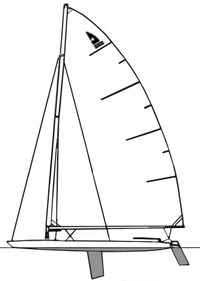C-Scow
The C-Scow is a 20 ft (6.1 m) member of the scow family. Like the MC, it is cat-rigged but requires two or three people to sail. Like the MC, it has bilgeboards but only one rudder. Although the current boat is one-design, the original class had several boats that fit within a box rule. The first scantlings for the class were developed in 1906, making the class 100 years old in 2006. The C-scow has spent most of its life as a small lake boat in the upper midwest. However, recent strong marketing efforts through its maker, Melges Performance Sailboats, has grown the fleet across the nation.
 Class symbol | |
 | |
| Development | |
|---|---|
| Design | One-Design (previously Box Rule) |
| Boat | |
| Crew | 2-3 |
| Hull | |
| Type | Monohull |
| Hull weight | 650 lb (290 kg) |
| LOA | 20 ft (6.1 m) |
| Beam | 8 ft 0 in (2.44 m) |
| Rig | |
| Rig type | Cat-rigged |
| Sails | |
| Mainsail area | 216 sq ft (20.1 m2) |
Sail numbers
Most sailboats classes use their Hull number or a number given by the national body to signify their boat (Hull number one in the US, would be USA 001, number 2 from Canada would be CAN 002 etc.). The C-scows were first built long before this numbering system existed and so they have their own system. Their sail numbers consist of a 1-2 letters followed by a number. The letters signify the lake, e.g. B is Lake Beulah, V is Pewaukee, M is Minnetonka, C is Calhoun, LP is Pelican Lake, MO is Lake Lotawana. The numbers are allocated by the sponsoring yacht club.